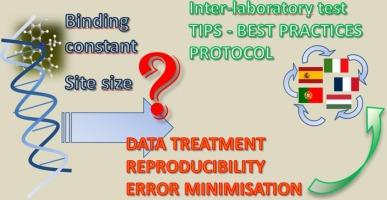How reliable is the evaluation of DNA binding constants? Insights and best practices based on an inter-laboratory fluorescence titration study
IF 4.3
2区 化学
Q1 SPECTROSCOPY
Spectrochimica Acta Part A: Molecular and Biomolecular Spectroscopy
Pub Date : 2024-10-28
DOI:10.1016/j.saa.2024.125354
引用次数: 0
Abstract
In all experimental sciences, the precision and reliability of quantitative measurements are paramount. This is particularly true when examining the interactions between small molecules and biomolecules/polyelectrolytes, such as DNAs/RNAs, and yet it is overlooked in most publications of thermodynamic binding parameters. This paper presents findings from COST Action 18202 “Network for Equilibria and Chemical Thermodynamics Advanced Research,” which assessed the consistency of data derived from the interactions of calf-thymus DNA (CT-DNA) with the fluorescent intercalator ethidium bromide (EB) through spectrofluorimetric titrations. We first discuss critical experimental aspects and propose a reference experimental protocol which can be used to calibrate procedures for the determination of nucleic acid binding equilibrium constants. We then fit the experimental points according to different procedures and analyse the results focusing on the statistical dispersion of the data, aiming at enlightening the strong and weak points of different fitting procedures. The implications of this work are significant, demonstrating how the statistical dispersion of experimental data can influence the interpretation of biochemical coordination mechanisms. Our study reveals that, despite rigorous protocol standardization, the determination of binding parameters remains sensitive to the choice of data fitting method, with deviations in the logarithmic stability constant (logK) values not falling below 5 % relative standard deviation (RSD), or ± 0.5 logK units for 95 % confidence. This variability evidences the critical need for standardized best practices in data treatment as well as experimental procedures. Although our study focuses on the EB/CT-DNA system through fluorescence titrations, the broader implications for other methodologies across various biochemical systems highlight the importance of this first-of-its-kind inter-laboratory comparison in advancing our understanding of biochemical coordination processes.

评估 DNA 结合常数的可靠性如何?基于实验室间荧光滴定研究的见解和最佳实践
在所有实验科学中,定量测量的精确性和可靠性至关重要。在研究小分子与生物大分子/多电解质(如 DNA/RNA)之间的相互作用时,这一点尤为重要,但在大多数有关热力学结合参数的出版物中却被忽视了。本文介绍了 COST 行动 18202 "平衡与化学热力学高级研究网络 "的研究成果,该研究通过分光荧光滴定法,评估了小牛胸腺 DNA(CT-DNA)与荧光插层剂溴化乙锭(EB)相互作用所得数据的一致性。我们首先讨论了关键的实验问题,并提出了一个可用于校准核酸结合平衡常数测定程序的参考实验方案。然后,我们根据不同的程序对实验点进行拟合,并以数据的统计分散性为重点对结果进行分析,旨在揭示不同拟合程序的强项和弱项。这项工作的意义重大,它展示了实验数据的统计分散性如何影响生化配位机制的解释。我们的研究发现,尽管实验方案已经严格标准化,但结合参数的确定对数据拟合方法的选择仍然很敏感,对数稳定常数(logK)值的偏差不会低于 5% 的相对标准偏差(RSD),或 95% 置信度下的± 0.5 logK 单位。这种变异性证明,在数据处理和实验程序方面亟需标准化的最佳实践。虽然我们的研究重点是通过荧光滴定法研究 EB/CT-DNA 系统,但它对各种生化系统中的其他方法具有更广泛的影响,这凸显了这种首创的实验室间比较法在促进我们对生化配位过程的理解方面的重要性。
本文章由计算机程序翻译,如有差异,请以英文原文为准。
求助全文
约1分钟内获得全文
求助全文
来源期刊
CiteScore
8.40
自引率
11.40%
发文量
1364
审稿时长
40 days
期刊介绍:
Spectrochimica Acta, Part A: Molecular and Biomolecular Spectroscopy (SAA) is an interdisciplinary journal which spans from basic to applied aspects of optical spectroscopy in chemistry, medicine, biology, and materials science.
The journal publishes original scientific papers that feature high-quality spectroscopic data and analysis. From the broad range of optical spectroscopies, the emphasis is on electronic, vibrational or rotational spectra of molecules, rather than on spectroscopy based on magnetic moments.
Criteria for publication in SAA are novelty, uniqueness, and outstanding quality. Routine applications of spectroscopic techniques and computational methods are not appropriate.
Topics of particular interest of Spectrochimica Acta Part A include, but are not limited to:
Spectroscopy and dynamics of bioanalytical, biomedical, environmental, and atmospheric sciences,
Novel experimental techniques or instrumentation for molecular spectroscopy,
Novel theoretical and computational methods,
Novel applications in photochemistry and photobiology,
Novel interpretational approaches as well as advances in data analysis based on electronic or vibrational spectroscopy.

 求助内容:
求助内容: 应助结果提醒方式:
应助结果提醒方式:


